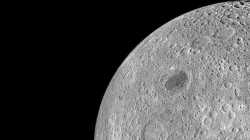NASA shares detailed image of Moon's far side, describes it as 'It's the side we never see..' | See pic
The US Space Agency, NASA, shared a never-before-seen photo of the moon on their official Instagram handle, which has amazed online viewers.

NASA regularly shares breathtaking images of space on social media, and their recent post unveiled an incredibly detailed picture of the far side of the Moon. This side, often mistakenly called the "dark side," is less known and has more craters and fewer dark plains compared to the side we see from Earth.
The far side of the Moon, which we don't see from Earth, is heavily cratered and has fewer dark plains called maria. Early astronomers thought these dark areas were oceans, but they are actually basaltic plains formed by volcanic eruptions. The term "maria" comes from the Latin word for "seas."
Photo details
The image shared by NASA is a mosaic of thousands of lunar farside images captured by the agency's Lunar Reconnaissance Orbiter (LRO). It shows the Moon's round, grey disc covered in craters of all sizes.
Tidally locked moon
NASA explained that the same side of the Moon always faces Earth because it's tidally locked. This means that the Moon's orbital period is the same as its rotation period, so it takes a whole month on Earth for the Moon to complete one rotation.
Viral reaction on social media
The Instagram post quickly went viral, accumulating millions of likes and reactions from amazed users within hours. Many people were captivated by the incredible detail captured in the image and dubbed it 'incredible.'
NASA's Lunar Reconnaissance Orbiter (LRO)
The LRO spacecraft, launched in June 2009, is about the size of a Mini Cooper car and equipped with seven instruments to observe the Moon. It orbits the Moon in a polar orbit at an altitude of about 50 kilometres, creating a 3D map of the Moon's surface.
ALSO READ | ISRO to launch meteorological satellite for better weather forecasts - Check details
ALSO READ | Snapchat faces server outage, users experience difficulty sending snaps and messages | DEETS inside
